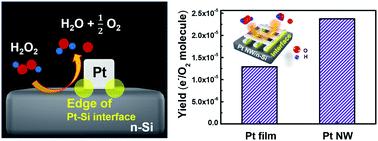当前位置:
X-MOL 学术
›
Nanoscale Adv.
›
论文详情
Our official English website, www.x-mol.net, welcomes your feedback! (Note: you will need to create a separate account there.)
Enhanced flux of chemically induced hot electrons on a Pt nanowire/Si nanodiode during decomposition of hydrogen peroxide
Nanoscale Advances ( IF 4.7 ) Pub Date : 2020-08-07 , DOI: 10.1039/d0na00602e Heeyoung Kim 1, 2 , Ye Ji Kim 3 , Yeon Sik Jung 3 , Jeong Young Park 1, 2
Nanoscale Advances ( IF 4.7 ) Pub Date : 2020-08-07 , DOI: 10.1039/d0na00602e Heeyoung Kim 1, 2 , Ye Ji Kim 3 , Yeon Sik Jung 3 , Jeong Young Park 1, 2
Affiliation

|
Identifying the charge transfer at metal–semiconductor interfaces by detecting hot electrons is crucial for understanding the mechanism of catalytic reactions and the development of an engineered catalyst structure. Over the last two decades, the development of catalytic nanodiodes has enabled us to directly measure chemically induced hot electron flux and relate it to catalytic activity. A crucial question is the role of interfacial sites at metal–oxide interfaces in determining catalytic activity and hot electron flux. To address this issue, a new design of catalytic nanodiodes employs nanoscale Pt wires and a semiconducting substrate. Here, we fabricated a novel Schottky nanodiode, a platinum nanowire (Pt NW) deposited Si catalytic nanodiode (Pt NW/Si) that exhibits an increased number of metal–semiconductor interfacial sites (Pt/Si) compared with a Pt film-based Si nanodiode (Pt film/Si). Two types of Pt/Si catalytic nanodiodes were utilized to investigate the electronic properties of the Pt/Si interface by detecting hot electrons and observing reactivity during the H2O2 decomposition reaction in the liquid–solid system. We show that the Pt NWs had higher catalytic activity because of the surface defect sites on the Pt NW surface. We observed a higher chemicurrent yield on the Pt NW/Si nanodiode compared with the Pt film/Si nanodiode, which is associated with the shortened travel length for the hot electrons at the edge of the Pt nanowires and results in a higher transmission probability for hot electron transport through metal–oxide interfaces.
中文翻译:

过氧化氢分解过程中 Pt 纳米线/Si 纳米二极管上化学感应热电子通量的增强
通过检测热电子来识别金属-半导体界面处的电荷转移对于理解催化反应的机理和开发工程催化剂结构至关重要。在过去的二十年里,催化纳米二极管的发展使我们能够直接测量化学诱导的热电子通量并将其与催化活性联系起来。一个关键问题是金属-氧化物界面处的界面位点在确定催化活性和热电子通量中的作用。为了解决这个问题,一种新的催化纳米二极管设计采用了纳米级 Pt 线和半导体衬底。在这里,我们制造了一种新颖的肖特基纳米二极管,铂纳米线 (Pt NW) 沉积的硅催化纳米二极管 (Pt NW/Si) 与基于 Pt 膜的 Si 纳米二极管 (Pt 膜/Si) 相比,其金属-半导体界面位点 (Pt/Si) 的数量增加。利用两种类型的 Pt/Si 催化纳米二极管通过检测热电子和观察 H 过程中的反应性来研究 Pt/Si 界面的电子特性2 O 2在液固体系中的分解反应。我们表明,由于 Pt NW 表面上的表面缺陷位点,Pt NWs 具有更高的催化活性。与 Pt 薄膜/Si 纳米二极管相比,我们观察到 Pt NW/Si 纳米二极管的化学电流产率更高,这与 Pt 纳米线边缘的热电子的行进长度缩短有关,并导致热电子的传输概率更高。通过金属-氧化物界面的电子传输。
更新日期:2020-10-13
中文翻译:

过氧化氢分解过程中 Pt 纳米线/Si 纳米二极管上化学感应热电子通量的增强
通过检测热电子来识别金属-半导体界面处的电荷转移对于理解催化反应的机理和开发工程催化剂结构至关重要。在过去的二十年里,催化纳米二极管的发展使我们能够直接测量化学诱导的热电子通量并将其与催化活性联系起来。一个关键问题是金属-氧化物界面处的界面位点在确定催化活性和热电子通量中的作用。为了解决这个问题,一种新的催化纳米二极管设计采用了纳米级 Pt 线和半导体衬底。在这里,我们制造了一种新颖的肖特基纳米二极管,铂纳米线 (Pt NW) 沉积的硅催化纳米二极管 (Pt NW/Si) 与基于 Pt 膜的 Si 纳米二极管 (Pt 膜/Si) 相比,其金属-半导体界面位点 (Pt/Si) 的数量增加。利用两种类型的 Pt/Si 催化纳米二极管通过检测热电子和观察 H 过程中的反应性来研究 Pt/Si 界面的电子特性2 O 2在液固体系中的分解反应。我们表明,由于 Pt NW 表面上的表面缺陷位点,Pt NWs 具有更高的催化活性。与 Pt 薄膜/Si 纳米二极管相比,我们观察到 Pt NW/Si 纳米二极管的化学电流产率更高,这与 Pt 纳米线边缘的热电子的行进长度缩短有关,并导致热电子的传输概率更高。通过金属-氧化物界面的电子传输。



























 京公网安备 11010802027423号
京公网安备 11010802027423号